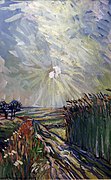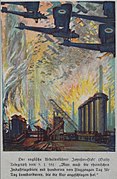Egon Tschirch
This article needs additional citations for verification. (October 2020) |
Egon Tschirch | |
|---|---|
Soviet occupation zone | |
| Nationality | German |
| Education | Academy of Arts Berlin |
Egon Tschirch (
Early years in the German Empire



From 1907 to 1912, Egon Tschirch attended three prestigious art academies in
Artistic breakthrough in the Weimar Republic
His most important creative period lasted from 1919 to the late 1920s. His productivity and willingness to experiment made him a fitful, yet successful, artist in Mecklenburg during the early Golden Twenties.[7] Some prominent examples of his work during this time were Boats with Fishermen (1922) at the Rostock Museum of Cultural History and Warnow Fishermen (1923) at Rostock Art Gallery. In 1923, Tschirch created his expressionist cycle of paintings centered around the biblical Song of Songs.[8] They were rediscovered in 2015 after being lost for more than 90 years. Tschirch was also considered a master of portrait art who was adept at capturing the character and traits of his clients.[9] Several members of Mecklenburg's bourgeoisie were portrayed by him. Examples of this are the portrait Max Samuel (1920) and the series of twenty Heads (1921), the latter of which was only labeled with numbers.[3]
Affiliation with Nazism
Beginning in the early
When the
In 1948, Egon Tschirch died childless in Rostock at the age of 58.[3]
Reception
In the summer of 1937, there were discussions about whether some of his works from the early 1920s should be classified as degenerate art and removed from the State Museum Schwerin. The intervention of advocates on his behalf prevented this.[13]
Tschirch was treated with caution and largely forgotten in East Germany.[14] Since 1998 several exhibitions have taken place in Rostock and Ahrenshoop.[3][4]
The first monograph on his life and work was published in 2020.[3] Tschirch has a street named after him in Rostock.[15]
Selected images
-
Sommertag, Summer day (1919)
-
Bassins des Aglabites, Kairouan (Tunisia) (1914)
-
Was der Feind will, What the enemy wants (1917/18)
-
Max Samuel (1920),(Portrait with suede brush)
-
Köpfe, Heads (1921), (Portrait Line Ristow)
-
Die zerstörte Stadt, The destroyed town (Rostock)(1942)
-
Egon Tschirch´s signature
References
- ^ Archiv der Hansestadt Rostock: Geburtsregister. 1889 Nr. 608
- ^ Archiv der Hansestadt Rostock: Sterberegister. 1948 Nr. 215
- ^ ISBN 978-3-356-02309-1
- ^ a b Egon Tschirch in Art Museum Ahrenshoop. https://kunstmuseum-ahrenshoop.de/ausstellungen/rueckschau/tschirch/ Website Kunstmuseum Ahrenshoop. Retrieved April 17, 2024.
- ^ Archive of the Academy of Arts, Berlin: Curriculum vitae by Egon Tschirch. May 18, 1910. In: Königliche Kunstschule – Alphabetisches Verzeichnis Schuljahr 1909/10
- ^ Werner Tschirch: Egon Tschirch, sein Leben. Eigenverlag, Berlin, 1974, p. 12-14
- ISBN 978-3-356-01406-8
- ^ Artmapp Frühjahr 2017: Das Hohelied in Farben, March 17, 2017, p. 44–47
- ^ Mecklenburger Warte, April 10, 1921
- ^ Marcus Pfab: Rostocker Kunst der 1920er bis 40er Jahre – Zwischen Traditionalismus und gemäßigter Moderne. Staatsexamensarbeit Universität Greifswald – Diplomarbeiten-Agentur, 1998, ID 929, p. 39
- ^ Archiv der Hansestadt Rostock, January 15, 1948, 1.2.0-1388 p. 285: Personalfragebogen
- ^ Werner Tschirch: Egon Tschirch, sein Leben. Eigenverlag, Berlin, 1974, p. 42
- ^ Landeshauptarchiv Schwerin: General-Akten betr. das Meckl. Landesmuseum 1929-1938, August 13/21/23 & September 8, 1937, 5.12-7/1 Nr. 6748
- ISBN 978-3-95655-583-1
- ^ https://onlinestreet.de/strassen/Egon-Tschirch-Weg.Rostock.575472.html Website Onlinestreet. Retrieved April 17, 2024.







